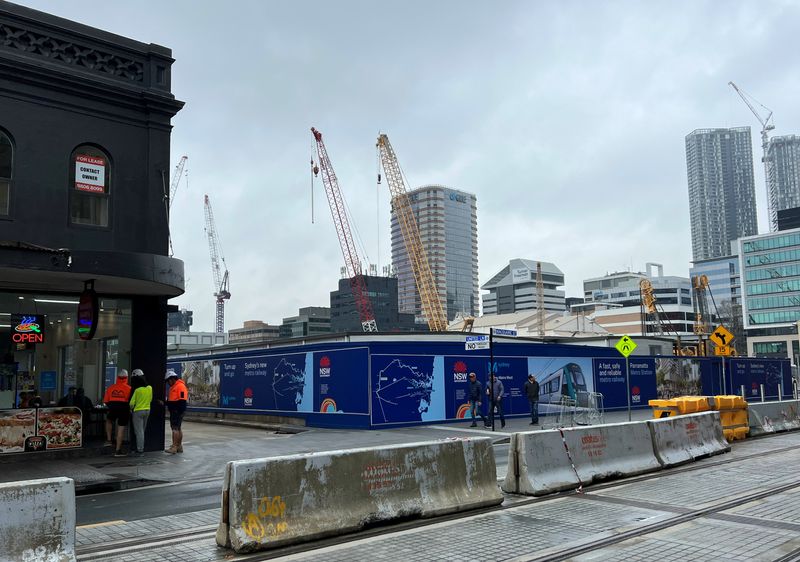
©Reuters. FILE PHOTO: A general view of a construction site where many high-rise apartment buildings have been built in recent years, in Parramatta, Sydney, August 14, 2023. REUTERS/Stella Qiu/File Photo
By Stella Qiu
SYDNEY (Reuters) – Australia’s economy grew at a snail’s pace in the December quarter as a sharp contraction in household incomes stalled consumer spending, reinforcing market bets that interest rates would soon fall.
Data from the Australian Bureau of Statistics on Wednesday showed real gross domestic product (GDP) rose 0.2% in the fourth quarter, compared with forecasts of 0.3%. That compared with an upwardly revised expansion of 0.3% in the previous quarter.
Annual growth slowed to 1.5%, down from 2.1% in the previous quarter and the lowest level since early 2021, when the economy was emerging from a pandemic-driven recession.
Reflecting the weakness of domestic demand, household spending did not contribute to economic growth at all in the fourth quarter, as a 0.7% increase in spending on basic necessities was offset by a 0.9% decline in discretionary spending.
ABS data showed households are spending more on electricity, rent, food and health, while cutting back on hotels, bars and restaurants, as well as things like buying new vehicles, clothing and footwear.
“Australian consumers are suffering from higher interest rates and cost of living pressures, while the rate of property investment remains in the doldrums,” said Stephen Smith, partner at Deloitte Access Economics.
“There is simply not enough demand in the Australian economy to justify the RBA’s statement on ‘domestic’ inflation… Monetary and fiscal policy must shift from containing inflation to stimulating economic growth.”
‘MUST ANSWER’
The Reserve Bank of Australia has raised interest rates by as much as 425 basis points from May 2022 to tame inflation, and has not ruled out another increase amid concerns about persistently high services inflation.
The central bank had expected the economy to slow to 1.5% annually by the end of last year and to 1.3% by mid-2024.
In the December quarter, GDP per capita fell 0.3%, contracting for three consecutive quarters in the longest streak of declines since 1982.
Although the household savings rate rose to 3.2%, it remained low after standing at 1.9% in the previous quarter.
Net trade was a big driver of growth, with a decline in imports – thanks to lower spending by Australians overseas – adding 0.7 percentage points to fourth-quarter GDP growth.
“Addressing inflation is still our primary concern, but these numbers show that the balance of risks in our economy is shifting from inflation to growth,” Treasurer Jim Chalmers said in a briefing.
“If you look at this quarterly data, if you look at the way inflation is playing out in a positive and encouraging way, we have to respond to that,” Chalmers said. The Government’s reworked Phase 3 tax cuts will be marketed in July this year. the relief of families.
Markets are confident that the RBA’s tightening cycle is over as inflation has fallen to a two-year low of 3.4%, although future prices show any rate easing will not arrive until August at the earliest.